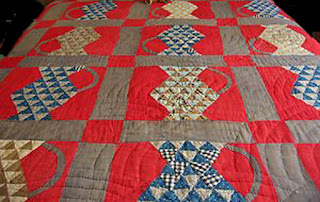Joyce's block certainly jumps off the cover of
the new edition of the Encyclopedia of Pieced Quilt Patterns.
We asked stitchers to choose a block and send it in. Hers
is #2765 published in the Kansas City Star in 1937
as Arkansas Centennial.
#2765 is an unusual block, all curved seams, a variation of Kaleidoscopes with straight sides
but more challenging.
Arkansas Centennial has a few cousins with eight curved seams meeting in the center.,
See posts on pattern relations here:
But not many people other than Joyce seem to have attempted this design.
A quick quilt from BlockBase shows a secondary
pattern in the corners.
12" pattern from BlockBase
Arkansas Centennial certainly looks good on the cover.
Thanks, Joyce.







































